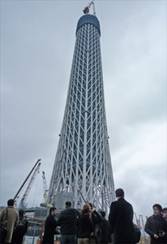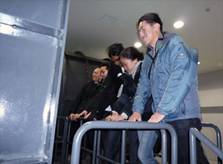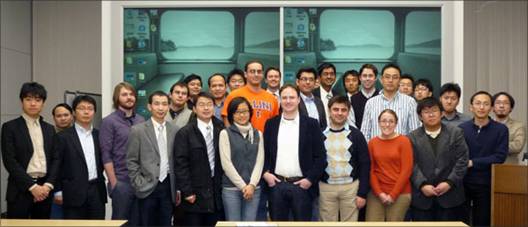oŨ
Home > oŨ > j [Y^[ > Conference Activities for Young Researchers
Conference Activities for Young Researchers
@CUEE, Assistant Professor, Troy Morgan@
As part of the recent joint assembly of the 7th Annual Conference on Earthquake Engineering and the 5th International Conference on Earthquake Engineering, a number of important activities were hosted to highlight the significant accomplishments of young researchers from around the world and to encourage their active participation in the conference program. As these young participants represent the future of research and practice in the field of seismic hazard mitigation, conference organizers felt that it was essential to include special events to foster their collaboration with one another. This is especially vital given the international theme of the conference and the increasing importance of developing research programs which include participants from multiple research centers worldwide.
 To encourage research collaboration between young researchers in Japan and the United States, a Young Researcher Workshop was held in conjunction with the Pacific Earthquake Engineering Research (PEER) Center located in Berkeley, USA. This Workshop took place on May 2nd, one day prior to the start of the main conference. In total, there were 25 Workshop participants, 11 from the United States and 14 from Tokyo Institute of Technology. These participants included graduate students, post-doctoral researchers, and assistant professors. All workshop participants are contributing heavily to transformative research programs in their respective fields, which include earth science, geotechnical engineering, ground motion scaling, seismic hazard mitigation for building and bridge structures, lifeline research, risk analysis, and social science.
To encourage research collaboration between young researchers in Japan and the United States, a Young Researcher Workshop was held in conjunction with the Pacific Earthquake Engineering Research (PEER) Center located in Berkeley, USA. This Workshop took place on May 2nd, one day prior to the start of the main conference. In total, there were 25 Workshop participants, 11 from the United States and 14 from Tokyo Institute of Technology. These participants included graduate students, post-doctoral researchers, and assistant professors. All workshop participants are contributing heavily to transformative research programs in their respective fields, which include earth science, geotechnical engineering, ground motion scaling, seismic hazard mitigation for building and bridge structures, lifeline research, risk analysis, and social science.
The Workshop was designed to expose participants to a range of current and emerging technologies being used in Japan for earthquake-resistant design. Additionally, the program was focused on allowing interaction between participants and encouraging mutual understanding of one anotherfs research projects. The program for the day included continuous activities from 8:00 AM until 8:00 PM, which were as follows:
- Tour of the new Tokyo Sky Tree (currently under construction, see picture above right) in Oshiage. This included a presentation from Nikken Sekkei, Ltd. describing the structural analysis and design, and the proposed construction methods and schedule. The tour allowed participants to enter the construction site and observe erection of the steel frame, which was about 50% complete at the time of the tour.
 Visit to the research laboratories at the Shimizu Institute of Technology in Sumida. This included a technical presentation on several recent seismic isolations projects, a tour of the Wind Tunnel Testing Laboratory (including actual typhoon simulation, see picture right), an introduction of several building system innovations related to environmental sustainability and energy savings, and a tour of the only building in the world incorporating the innovative core-suspended isolation system.
Visit to the research laboratories at the Shimizu Institute of Technology in Sumida. This included a technical presentation on several recent seismic isolations projects, a tour of the Wind Tunnel Testing Laboratory (including actual typhoon simulation, see picture right), an introduction of several building system innovations related to environmental sustainability and energy savings, and a tour of the only building in the world incorporating the innovative core-suspended isolation system.- Technical session at Tokyo Tech Tamachi campus where all young researchers were given the opportunity to give a short presentation about their current field of research and answer questions from fellow attendees.
- Dinner party at the restaurant Kinnokura in Oimachi, showcasing Japanese cuisine which included shabu shabu, yakitori, and a variety of delicious side dishes.

Young Researchers Workshop attendees
Based on feedback from the students in a post-event evaluation survey developed by Ms. Heidi Faison, outreach coordinator at the PEER Center, the day was highly successful. One of the student participants commented "it was a good idea to have this workshop before the conference so young researchers know each other and have an idea about what others are working on and share thoughts and have useful discussions as was done." Another participant noted "I had a very good opportunity at this CUEE 2010 conference. I hope CUEE will continue to have a Young Researchers Workshop as this in the future." It was clear that participation in the workshop not only lead to better understanding of current and promising trends in earthquake engineering in Japan, but also enabled better communication and collaboration in the joint conference that followed.
In addition to the Workshop, the conference included a special series of presentation sessions that highlighted the research accomplishments of young conference participants. These sessions were arranged by engineering discipline, which included: advanced technologies, concrete structures, steel structures, earthquake engineering design criteria, engineering seismology, geotechnical engineering, and bridge and lifeline structures. All young researchers made full oral presentations that were judged by an international panel of four prominent experts. Awards were then given to the top two presenters for each session based on technical quality, effective communication, and response to questions. At least one student found these discipline-specific sessions to be an opportunity for networking: "There was some overlap of my research with other people. We exchanged contact information and I'm hoping we can find some common research goals in the future."

Best Young Researchers Presentation Award winners
Congratulations to all Workshop and Young Researcher sessions contributors for their significant research accomplishments. In particular, special thanks are given to judges for all special sessions, including: Bill Spencer, Kazuhiko Kasai, Fabio Casciati, Akira Wada, John Wallace, Junichiro Niwa, John Stanton, Hiroyasu Sakata, Gregory Deierlein, Toru Takeuchi, Stephen Mahin, Satoshi Yamada, Xilin Lu, Tatsuo Ohmachi, Jerome Hajjar, Ryuzo Ohno, John Anderson, Saburo Midorikawa, Kuo-Liang Wen, Hiroaki Yamanaka, Ross Boulanger, Kohji Tokimatsu, Ahmed Elgamal, Jiro Takemura, David Lau, Kazuhiko Kawashima, Lucia Faravelli, and Kiyoshi Ono. Presentation award winners, their positions and affiliations, and the title of their presentation are listed below:
| Emmanuel H. Javelaud, Civil Engineer, Menard Inc. | |
| gA Quantitative Approach to Estimate Coseismic Displacements in the Near-Field from Strong-Motion Accelerographs: Example of the 2007 Niigata-Ken Chuetsu-Oki Earthquake, Japanh | |
| Hussam Mahmoud, Graduate Student, University of Illinois | |
| gSystem-Level Seismic Evaluation of Partial-Strength Semi-Rigid Steel Frames using Hybrid Simulationh | |
| Kotaro Sakurai, Graduate Student, University of Tokyo | |
| gExperimental Study on In-Plane and Out-of-Plane Behavior of PP-Band Retrofitted Masonry Wallette Made of Shapeless Stonesh | |
| Kouhei Sawada, Graduate Student, Tokyo Institute of Technology | |
| gMechanical Behavior of Piled Raft Foundation in Sand Subjected to Static Horizontal Loadh | |
| Kyohei Ueda, Graduate Student, Kyoto University | |
| gLarge Deformation Analysis of Dynamic Behavior of Embankment on Liquefiable Sand Deposit Using a Strain Space Multiple Mechanism Modelh | |
| Muhammad Kashif Razzaq, Graduate Student, Saitama University | |
| gEffect of Rubber Bearingfs Modeling on Seismic Response of Base Isolated Highway Bridgeh | |
| Nirmal Jayaram, Graduate Student, Stanford University | |
| gGround-Motion Selection for PEER Transportation Research Programh | |
| Pher Errol B. Quinay, Graduate Student, Tokyo Institute of Technology | |
| gDevelopment of a Forward-Inversion Crust Modeling Scheme for Accurate Strong-Ground Motion Predictionh | |
| Richelle Zafra, Graduate Student, Tokyo Institute of Technology | |
| gEffect of Fiber Reinforced Cement Composites on the Seismic Performance of Bridge Columnsh | |
| Sangjoon Park, Graduate Student, University of California, Berkeley | |
| gAnalytical and Experimental Study on RC Exterior Beam-Column Joints without Transverse Reinforcementh | |
| Syam Rachma Marcillia, Graduate Student, Tokyo Institute of Technology | |
| gResidentsf Evaluation in Java 2006 Earthquake Post Disaster Settlement-Case Study of New Ngelepen, Sleman, Yogyakarta-h | |
| Yao Cui, Postdoctoral Researcher, Kyoto University | |
| gSeismic Behavior of a New Steel Beam-Column Connection Using Steel Fiber Reinforced Cementitious Composite (SFRCC)h | |
| Yoshihiro Yamazaki, Graduate Student, Tokyo Institute of Technology | |
| gTorsional Seismic Response Reduction by Passive Control Devise for Conventional Post-And-Beam One-Story Wooden House with Stiffness Eccentricityh | |
| Zhe Qu, Graduate Student, Tsinghua University | |
| gStrength Deterioration Model Based on Effective Hysteretic Energy Dissipation for RC Members under Cyclic Loadingh | |
